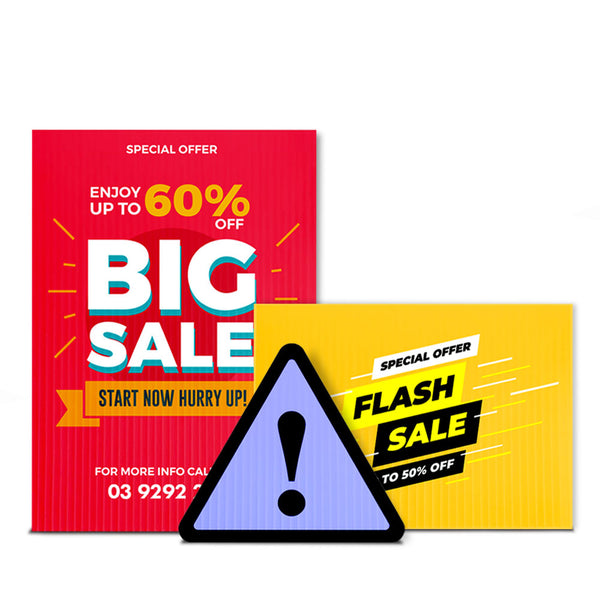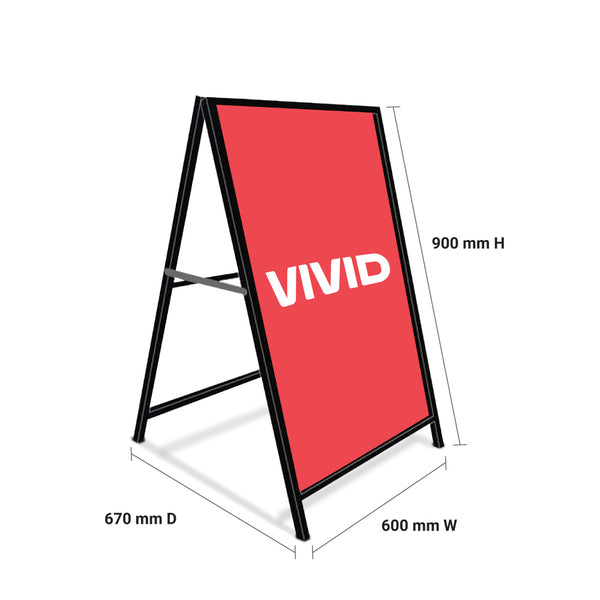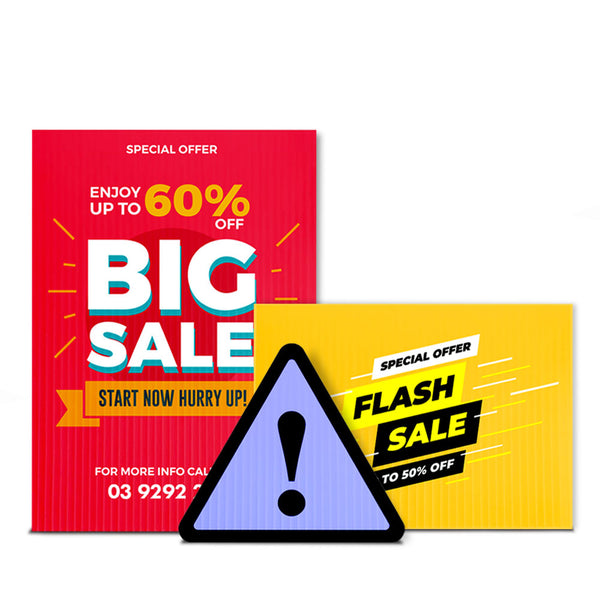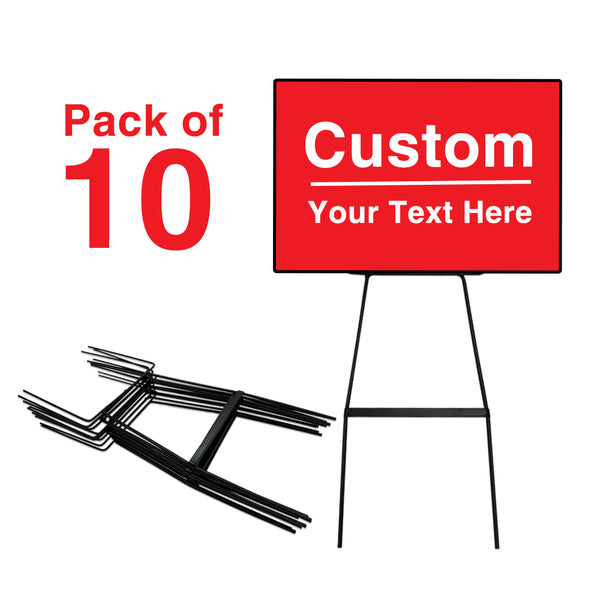Most Commonly Asked Questions About Corflute Signs
What is a corflute sign?
A corflute sign is a type of lightweight, portable sign that is made from corrugated plastic, also known as corflute. It is a popular choice for temporary signage because it is inexpensive, durable, and easy to handle. Corflute signs are commonly used for real estate signs, event signage, construction site signage, and political campaign signs. They are also often used as yard signs or to display directional or informational messages. Corflute signs are typically printed with high-quality digital printing equipment and can be customized with text, graphics, and images. They can be mounted on a variety of surfaces using stakes, stands, or other types of hardware.

How long do corflute signs last?
Corflute is a type of corrugated plastic that is commonly used for temporary signs. It is lightweight, durable, and resistant to water, making it a popular choice for outdoor signage. The lifespan of a corflute sign can vary depending on the conditions it is exposed to and the level of care it receives. In general, corflute signs can last for several months to a few years if they are well-maintained and not subjected to extreme weather conditions or vandalism. To extend the lifespan of your corflute sign, it is important to store it in a dry, sheltered location when it is not in use and to clean it regularly to remove any dirt or debris that may accumulate on its surface.
Are Corflute Signs Corflute cheap to buy?
Corflute signs are generally considered to be an affordable option for temporary signage. The cost of a corflute sign can vary depending on the size, design, and quantity you need, as well as any additional features or finishes you may want. In general, you can expect to pay anywhere from a few dollars to several hundred dollars for a corflute sign, depending on your specific needs and budget. Some factors that can affect the price of a corflute sign include the complexity of the design, the number of colors used, and whether you need any special finishes or treatments applied to the sign, such as UV protection or anti-graffiti coating.

Can you print on corflute?
Yes, it is possible to print on corflute, which is a type of corrugated plastic sheeting. This material is often used for signs, displays, and packaging due to its durability, lightweight, and versatility.
There are a few different methods for printing on corflute, including screen printing, digital printing, and litho printing. The most suitable method will depend on the specific requirements of your project, such as the quantity of prints needed, the size of the prints, the type of ink or toner being used, and the desired finish.
It is important to note that corflute has a slightly textured surface, which may affect the quality of the print. It is also a porous material, so the ink or toner may not adhere as well as it would on a smoother surface. To get the best results, it is recommended to use a high-quality printer and ink or toner specifically designed for printing on corrugated plastic.
For commercial corflute printing visit vividads.com.au
Can corflute get wet?
Corflute is a type of corrugated plastic sheeting that is commonly used for signs, packaging, and other applications where a lightweight, durable material is needed. It is made of a plastic called polypropylene, which is resistant to moisture and water. This means that corflute can generally withstand being exposed to wet conditions and will not become easily damaged or weakened when it gets wet. However, it is not completely waterproof, and prolonged exposure to water or very high levels of humidity may cause the material to become discolored or weakened over time. It is always best to try to keep corflute as dry as possible to ensure its longevity and maintain its strength and appearance.That is the reason corflutes are used for temporary signage which would easily last for 6 months to 1 year.

How durable is corflute?
Corflute is generally considered to be quite durable and resistant to damage. It is resistant to moisture and most chemicals, and it can withstand extreme temperatures. However, it is not as strong as some other plastic materials, and it can be easily scratched or dented if subjected to heavy impacts. Overall, corflute is a useful material for many applications where a lightweight, waterproof, and durable material is needed.
Does corflute decompose?
It is not biodegradable and can take hundreds of years to decompose in a landfill. However, it can be recycled and many recycling programs accept corflute. If you are looking for a more environmentally-friendly alternative, there are a number of biodegradable and compostable materials available on the market that can be used in place of corflute.

How do you stick corflute together?
There are a few different ways that you can stick corflute together:
-
Use adhesive tape or double-sided tape. This is a quick and easy option that works well for small projects.
-
Use a hot glue gun. This method works well for attaching corflute to other materials, but be careful not to apply too much heat or the corflute may melt.
-
Use a solvent-based glue. This method works well for bonding corflute to itself, but the glue can be difficult to work with and may emit fumes.
-
Use screws or bolts. This is a more permanent option that works well for attaching corflute to a frame or other structure.
-
Use a stapler. This method works well for attaching corflute to fabric or other soft materials, but may not be as secure as other options.
It's important to keep in mind that the best method for sticking corflute together will depend on the specific project you are working on and the materials you have available.
What are the advantages of corflute?
Some of the main advantages of corflute include:
- Lightweight: Corflute is very lightweight, making it easy to handle and transport. This makes it a popular choice for signage and displays that need to be moved frequently.
- Durable: Corflute is resistant to water, UV rays, and most chemicals, making it a long-lasting material that can withstand harsh weather conditions.
- Versatile: Corflute can be easily cut, shaped, and printed on, making it a versatile material that can be used in a variety of applications.
- Recyclable: Corflute is made from HDPE, which is a type of plastic that can be recycled after use. This makes it an environmentally friendly choice for packaging and other applications.
- Affordable: Corflute is a cost-effective material that is widely available and can be purchased at a reasonable price.
Is Corflute toxic?
Corflute is a brand name for a type of corrugated plastic sheeting. It is made of polypropylene, a synthetic polymer that is considered to be safe for use in a variety of applications. While polypropylene is not considered to be toxic, it is always a good idea to handle any materials with care and to follow proper safety procedures when working with them.
How long do corrugated plastic signs last?
Corrugated plastic signs can last for several years if they are properly cared for. Factors that can affect the lifespan of a corrugated plastic sign include the type of ink used, the environment in which the sign is displayed, and the type of mounting hardware used. In general, corrugated plastic signs that are printed with UV-resistant ink and are displayed in a protected area will last longer than those that are not.

Can you paint Corflute?
Yes, you can paint Corflute. Corflute is a brand of corrugated plastic sheeting that is often used for temporary signage and other lightweight applications. It is made of polypropylene and is easy to cut, bend, and shape. It is also relatively easy to paint, although it does require some special considerations.
To paint Corflute, you will need:
- Corflute sheets
- Acrylic paint
- A paintbrush or roller
- Masking tape (optional)
Here are the steps to follow:
- Clean the Corflute sheets to remove any dirt or debris. You can use a mild detergent and water to do this.
- Allow the sheets to dry completely.
- If you want to create a border or a design on the Corflute, use masking tape to mark off the areas that you do not want to paint.
- Apply the paint to the Corflute using a paintbrush or roller. You may need to apply multiple coats to get the desired coverage and color.
- Allow the paint to dry completely before removing the masking tape, if you used it.
Keep in mind that Corflute is not a very porous material, so the paint may not adhere as well as it would to other surfaces. You may need to use a primer or a paint specifically designed for use on non-porous surfaces to get the best results.
What will stick to corflute?
There are several types of adhesives that can be used to attach items to corflute. Some options include:
- Hot glue: This is a strong and fast-drying adhesive that can be used to attach a variety of materials to corflute.
- Double-sided tape: This type of tape is ideal for attaching lightweight items to corflute and can be easily removed without leaving a residue.
- Contact cement: This is a strong adhesive that is ideal for attaching heavier items to corflute. It requires a few hours to dry and once it has dried, it creates a permanent bond.
- Silicone glue: This is a strong and flexible adhesive that is ideal for attaching items that may need to be removed or repositioned in the future.
It is always a good idea to test a small area before applying any adhesive to a large surface to ensure that it will work as desired.
How do you cut a corflute?
Here are some steps you can follow to cut corflute:
- Gather your materials. You will need a sharp blade (such as a box cutter or utility knife), a straight edge (such as a ruler or straight edge), and a cutting mat or other protective surface.
- Place the corflute on the cutting mat.
- Use the straight edge to guide the blade as you cut along the desired line. You may find it helpful to score the surface of the corflute first by lightly dragging the blade over the surface in a straight line. This will help prevent the blade from slipping and give you a clean, straight cut.
- Use gentle, even pressure as you cut through the corflute. If you are using a box cutter or utility knife, you may need to apply a little more pressure to cut through the thicker layers of the corrugated plastic.
- Once you have cut all the way through the corflute, remove the excess material and smooth the edges of the cut with a sanding block or fine-grit sandpaper.
Remember to use caution when cutting corflute, as the blade can be sharp and the plastic can be slippery. It may be helpful to wear gloves and eye protection while cutting.
For commercial corflute printing in different shapes and sizes please your order on our website.
Can you laminate corflute?
Yes, you can laminate corflute. Corflute is a type of corrugated plastic material that is lightweight, durable, and weather resistant. It is commonly used for signage, packaging, and other applications where a lightweight, waterproof material is needed. Laminating corflute involves applying a layer of plastic film or other material over the surface of the corflute to protect it and give it additional strength and stability. This can be done using a laminating machine or by hand using a heat gun or other heating device. It is important to follow the manufacturer's instructions carefully when laminating corflute to ensure the best results.
Is corflute a PVC?
It is not made from PVC (polyvinyl chloride).
Can you use whiteboard marker on corflute?
Yes, you can use a whiteboard marker on corflute, a type of corrugated plastic sheeting. Corflute is a smooth, white material that is similar in texture to cardboard, and it can be easily written on with a whiteboard marker. However, keep in mind that the ink from a whiteboard marker may not adhere as well to corflute as it does to a traditional whiteboard, so the writing may not be as long-lasting. Additionally, the ink may smear or smudge more easily on corflute than it would on a whiteboard.
How are corflute signs printed?
Corflute signs are printed using a variety of methods, including screen printing, digital printing, and lithographic printing.
Screen printing involves creating a stencil of the design, and then using a screen printing press to apply ink through the stencil and onto the surface of the corflute. This method is suitable for printing large quantities of signs, and is often used for printing simple designs with solid colors.
Digital printing involves printing the design directly onto the corflute using specialized digital printers. This method allows for more flexibility and allows for the printing of more complex designs with a wider range of colors.
Lithographic printing, also known as offset printing, involves printing the design onto a metal plate, which is then used to transfer the design onto the corflute. This method is suitable for printing large quantities of signs, and is often used for printing detailed designs with a wide range of colors.
Is Corflute a cardboard?
It is similar to cardboard in that it is a flat, flexible sheet material that can be used for a variety of purposes. However, it is not made from paper like cardboard, and it is more durable and resistant to water and other types of damage. It is often used as a low-cost alternative to cardboard for applications such as temporary signs, packaging, and construction.
What is another name for corflute?
It is also known by other names such as coroplast, flute board, signflute, coriflute and fluted polypropylene.
What is Corflute used for?
Corriflute is a brand name for a type of corrugated plastic sheeting that is commonly used for a variety of applications, including:
-
Signs and displays: Corriflute is often used for temporary signs, point-of-sale displays, and event signage because it is lightweight, durable, and easy to cut and print on.
-
Packaging: Corriflute is also used as a packaging material because it is strong and can be easily cut and formed into custom shapes.
-
Construction: Corriflute can be used as a temporary protective covering on construction sites, as well as for barricades and temporary fencing.
-
Agricultural: Corriflute is sometimes used in agriculture for applications such as tree protection, windbreaks, and plant support.
-
Other: Corriflute may also be used for a variety of other applications, such as temporary floor protection, event seating, and more.
What is corflute made from?
Corflute is also known by other names, including coroplast and fluteboard, and is often used as a substitute for cardboard in many applications.Its made up of plastic.
How do you pronounce corflute?
Corflute is pronounced "KAWR-flute." The "cor" part is pronounced like the word "core," and the "flute" part is pronounced like the musical instrument.
Is corrugated plastic waterproof?
Corrugated plastic is a type of plastic material that is made up of three layers: a wavy inner layer sandwiched between two flat outer layers. It is often used as a lightweight, waterproof and durable alternative to corrugated cardboard. In general, corrugated plastic is considered to be waterproof, as the corrugated design helps to channel water away from the surface and prevent it from soaking in. However, it is important to note that the degree of waterproofing can vary depending on the specific type of corrugated plastic and the quality of its manufacture. Some corrugated plastics may be more water-resistant than others, and the ability of the material to resist water may also be affected by factors such as age, exposure to UV light, and wear and tear.
What is the origin of the word Corflute?
"Corflute" is a combination of "corrugated" and "flute," which refers to the fluted shape of the material. The material was invented in the 1950s and has become popular in recent years due to its low cost, durability, and versatility.
Is corflute fire resistant?
It is not inherently fire resistant, but it can be treated to be made more fire resistant. This can be done through the use of fire retardant coatings, which can be applied to the surface of the corflute to reduce its flammability. The effectiveness of these coatings can vary, so it is important to carefully consider the specific fire resistance needs of your application before choosing a corflute product.
Can you reuse Corflute?
It is generally not recommended to reuse Corflute, as it may become damaged or dirty during use, and the integrity of the material may be compromised. However, if the Corflute is in good condition and has not been contaminated, it is possible to reuse it for certain applications. It is a good idea to clean the Corflute thoroughly before reusing it to ensure that it is in good condition.
Can you cut corrugated plastic with scissors?
Yes, you can cut corrugated plastic with scissors. However, depending on the thickness of the plastic and the type of scissors you are using, it may be more difficult to cut the plastic cleanly and accurately. If you are trying to make precise cuts, you may find it easier to use a utility knife or a rotary cutter. These tools will allow you to get a cleaner and more precise cut, especially if you are cutting through thicker corrugated plastic.
Order your corflute signs from vividads.com.au
Looking to order commercially printed corflute signs in different shapes and sizes ? Get a quote online and place your order online on vividads.com.au




